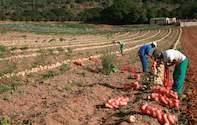Crop Rotation
It is good to rotate with other crops like grains, alliums and leafy vegetables.
Yield (tonnes per hectare)
Conservative: 15 tonnes Average: 20 tonnes Good: 30+ tonnesHarvesting
Harvesting starts from about 90 days after planting of seeds or about 30 days after fruit set. Harvest when the butternut’s outer skin or rind starts to harden. Do not leave the butternut to fully ripen before picking as this stops flower production and reduces yields.
Cut or pull off the butternut with a small part of the stalk attached as this prolongs shelf and storage life. Do not damage the skin as this promotes disease and decay. Harvest can continue for about a month.
Some growers allow the plant to continue flowering and can harvest for longer and yield two crops in a planting.
Storage
Butternut can be stored for up to three months in rooms with ample air movement and ventilation between the fruit. Before storage the butternuts must be properly cured.
This is done either in the field for about 12 days as long as there is no rain and the weather is warm and dry or in rooms with artificial heating at a temperature of about 26°C and relative humidity of 80%. After curing the butternut, long-term storage temperature should be 10°C to 11°C with a relative humidity of 70%.